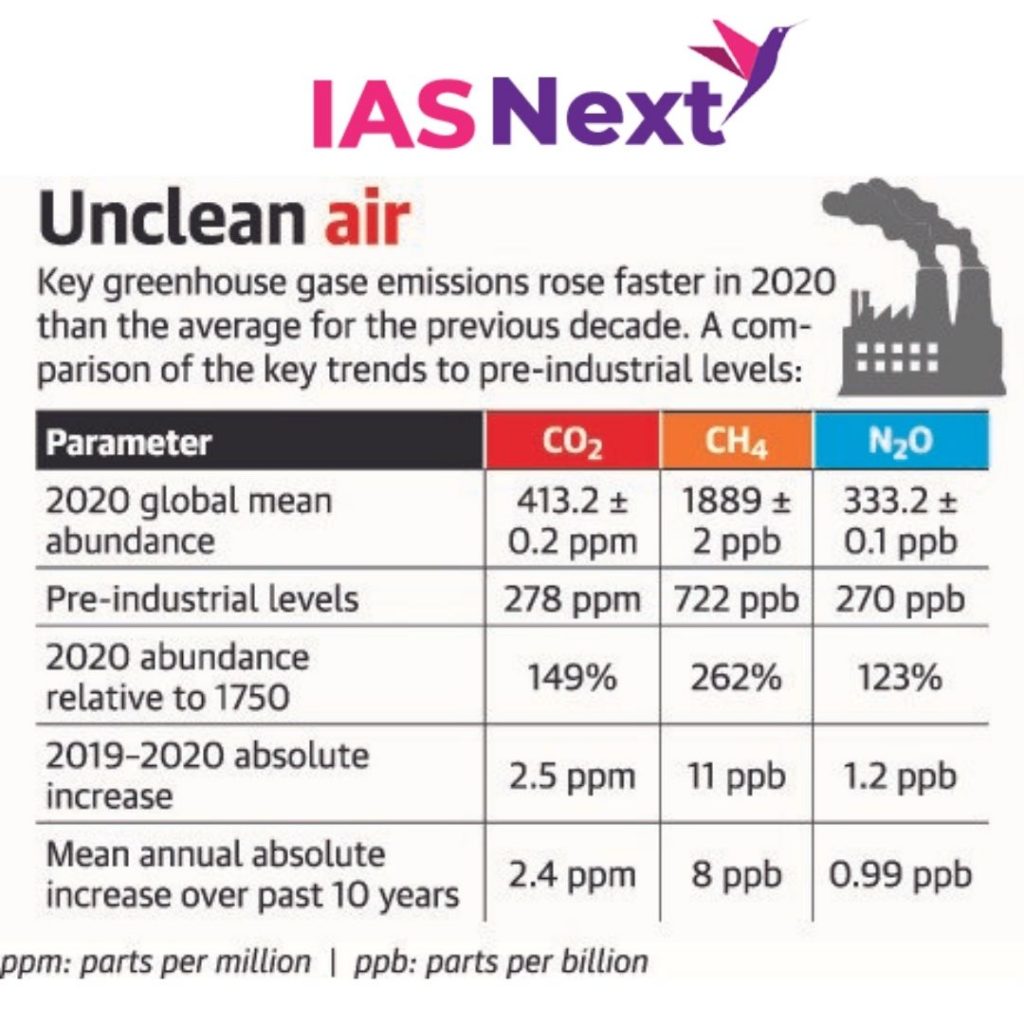CURRENT AFFAIRS
Get the most updated and recent current affair content on Padhaikaro.com
WMO report on CO2 emissions:
- IAS NEXT, Lucknow
- 27, Oct 2021

The World Meteorological Organisation (WMO) has recently released a report on CO2 emissions.

Key findings:
- The increase in CO2 from 2019 to 2020 was slightly lower than that observed from 2018 to 2019 but higher than the average annual growth rate over the past decade.
- This is despite the approximately 5.6% drop in fossil fuel CO2 emissions in 2020 due to restrictions related to the pandemic.
- For methane, the increase from 2019 to 2020 was higher than that observed from 2018 to 2019 and also higher than the average annual growth rate over the past decade.
- For nitrous oxides, the increase was higher and also than the average annual growth rate over the past 10 years.
- Concentration of carbon dioxide (CO2), the most significant greenhouse gas, reached 413.2 parts per million in 2020 and is 149% of the pre-industrial level. Methane (CH4) is 262% and nitrous oxide (N2O) is 123% of the levels in 1,750 when human activities started disrupting earth’s natural equilibrium.
- Roughly half of the CO2 emitted by human activities today remains in the atmosphere. The other half is taken up by oceans and land ecosystems.
- From 1990 to 2020, radiative forcing — the warming effect on our climate — by long-lived greenhouse gases increased by 47%, with CO2 accounting for about 80% of this increase.
Concerns:
- The ability of land ecosystems and oceans to act as ‘sinks’ may become less effective in future, thus reducing their ability to absorb CO2 and act as a buffer against larger temperature increase.
- At the current rate of increase in greenhouse gas concentrations, we will see a temperature increase by the end of this century far in excess of the Paris Agreement targets of 1.5 to 2 degrees Celsius above pre-industrial levels.
About WMO:
- The World Meteorological Organization (WMO) is a specialized agency of the United Nations dedicated to meteorology (weather), climatology (climate), operational hydrology (water) and other related geophysical sciences such as oceanography and atmospheric chemistry.
- Predessor organization — International Meteorological Organization (IMO) — founded in 1873.
Reports:
- Greenhouse Gas Bulletin.
- Status of the World Climate.
What does WMO do?
- WMO coordinates the activities of National Meteorological and Hydrological Services in 191 States and Territories so that basic weather, climate and water services are made available to anyone who needs them, when they need them.
- WMO guarantees the publication of observations and statistics and furthers the application of meteorology and hydrology (including the monitoring and predictions of climate change and ozone) to all aspects of human activities such as aviation, shipping, water management and agriculture.
- WMO also encourages research and training in meteorology and hydrology and their related applications and contributes towards reducing the impact of weather- and climate-related hazards. This is accomplished through regular, reliable forecasts and early warnings on flooding, drought, tropical cyclones, tornadoes and other extreme events.
- Predictions concerning locust swarms and the transport of pollutants (nuclear and toxic substances, volcanic ash) are also provided by WMO Members.”